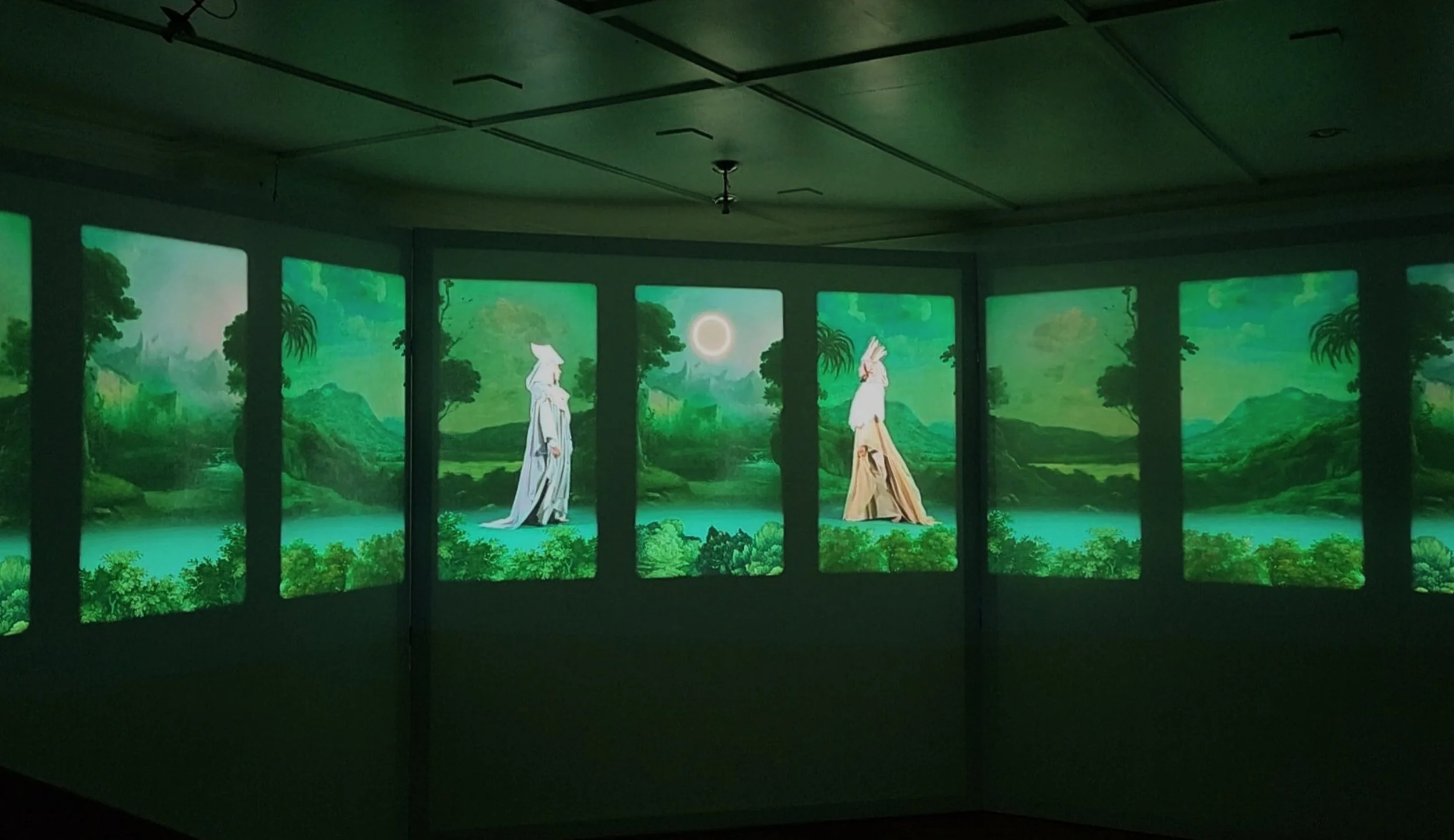
Celestial Bodies.
A celestial body is a naturally occurring physical entity, such as a sun, planet, moon, or asteroid that exists in the observable universe. Over the course of human history, there has existed an evolving relationship between us and our most influential celestial bodies; the sun and the moon. They inspire humanity, they impact us by their very existence, but still, historically in myth and story, we have given them extra power by imbuing them with personality, motive and even deification.
In the case of this work, Sol and Luna allow us to see them in their humanised forms as they travel their intersecting paths across an idyllically scenic yet brooding realm. Sun and moon, gold and silver, pass across the sky meeting once to ‘touch’ in an eclipse redolent of ‘conjunctio’, the alchemical marriage. While we are watching them, only once do they turn to face us and acknowledge our gaze, but even then they look through and beyond us, as if our existence doesn’t touch them at all.

Celestial Bodies (Eclipse) installed in CAS Gallery, New Plymouth, 7 May 2022 - 25 June 2022

Celestial Bodies (Eclipse) 2022, Video installation, 6mins
Celestial Bodies prints.
Three images are available as limited edition prints NZ$230.
Edition of 10, 400x600mm Fine Art Photographic Print on Ilford Smooth 100% Cotton Rag 310gsm
Lunar Transit (2022) Edition of 10, 400x600mm Fine Art Photographic Print on Ilford Smooth 100% Cotton Rag 310gsm NZ$230 Contact for shipping cost
Theory of Tides I (2022) Editon of 10, 400x600mm Fine Art Photographic Print on Ilford Smooth 100% Cotton Rag 310gsm NZ$230 Contact for shipping cost
Heliospheric Current II (2022) Edition of 10, 400x600mm Fine Art Photographic Print on Ilford Smooth 100% Cotton Rag 310gsm NZ$230 Contact for shipping cost










Celestial Bodies catalogue.
Images and text accompanying the video work ‘Celestial Bodies’. Twenty full colour A5 pages printed on heavy Mohawk Eggshell textured stock. NZ$20
Celestial Bodies.
“For he is ever a sun, and she a moon. But to him is the winged secret flame, and to her the stooping starlight.”
‘The Alchemist’ from Clavis Artis (1737) Original attributed to Zoroaster
Alchemical marriage between Sun and Moon (1578) Jaroš Griemiller, Rosarium Philosophorum
“Its father is the Sun and its mother the Moon.The Earth carried it in her womb, and the Wind nourished it in her belly, as Earth which shall become Fire. Feed the Earth from that which is subtle, with the greatest power. It ascends from the earth to the heaven and becomes ruler over that which is above and that which is below.
”
From Splendor Solis (1582) a German alchemical treatise, held in the British Library
There’s an old alchemical illustration that has captivated me since the first time I saw it; one of those images that seems to follow you around and keep appearing again and again to worm its way into your psyche. In this strange picture from the Clavis Artis a figure sits in a wooden chair, turned three quarter view and with their left foot in front of the right. Behind them is a sweeping natural landscape with a glowing sky and rolling hills. The figure’s right hand relaxes on
the arm of the chair while their left hand holds a stem with three flowers.
This person is an alchemist and it seems they have reached an enlightened state as their head has taken on the form of a golden sun, seen by alchemists as the divine heart of the macrocosm and a representation of spiritual perfection. Along with his partner the moon, these two celestial bodies perform the ‘conjuctio’ or alchemical marriage, through which the Magnum Opus, the process of attaining perfection or the widely coveted Philosophers Stone, is achieved.
The Red King and White Queen (Sun and Moon) represent a pair of binary opposites; male and female, king and queen, fire and water, active and receptive, whose conjunction creates a perfect union. This symbolic language exists far more universally than just in alchemical texts through the mythology of world wide cultures.
While solar deities are not always understood to be masculine and lunar deities feminine (many cultures have aspects of both that relate to the opposite sex) this is the tradition that has filtered through western esoteric thought from ancient European and Near Eastern civilisations such as Mesopotamia, Egypt and Greece.
It is not surprising that humans have held the sun and the moon in such high regard, even venerating them, when you consider the impact both of these celestial bodies have upon our lives.
Without the sun there would be no life upon the earth, there would be no seasons and no day. Without the moon there would be no tides, there would be no light to guide us when it is dark. They are the two halves of our 24 hour daily cycle, exhibiting their own rhythms as they move with the months or years. The fierce gold and the radiant silver.
Alchemical artworks are loaded with symbolism designed to be understood by adepts while being overlooked by the layperson. A fine example of what is meant, in this case, by the epithet ‘occult’ or ‘hidden’ whereby only those possessed of the correct esoteric knowledge can read the imagery to its full. As well as continuing didactic traditions from illuminated manuscripts these metaphorical artworks often have an unusual way of staging the scene by placing the ‘feature’ of the visual lesson into a pastoral or scenic landscape with which it has little or no connection.
The feature subject is usually larger than it’s surrounds and can appear to float apart from the landscape as if existing in a separate plane.
In this image from Splendor Solis, “The Splendor of the Sun” (1582) attributed to legendary Renaissance alchemist Salomon Trismosin, a red garbed man stands inside a giant flask which floats above a scene of rustic hunting and fishing. The flask sits inside an architectural device which separates it from the landscape as the artist encourages the viewer to hold it in higher regard as the symbolic focus of the entire painting. The Red King in this miniature alludes to the alchemical phase of rubedo which is associated with the production of gold, while above the scene, in her chariot drawn by two maidens, the goddess Luna carries her emblem the crescent moon, alluding to silver.
A celestial body is a naturally occurring physical entity, such as a sun, planet, moon, or asteroid that exists in the observable universe. But I also interpret the appellation as a description of the personhood bestowed upon these insentient entities. The sun, the moon and the planets of our solar system feature so prominently in human thought, from ancient mythology to modern science and everything in between, that the word ‘body’ conjures up both their physical form and the corporeal shape of the deities humanity has made of them.
With this work I wanted to visualise the way, over the course of human history, there has been a backwards and forwards between us and our nearest celestial bodies. They inspire humanity, they impact us by their very existence, but still we give them extra power by imbuing them with personality, motive and even deification: if we don’t give sacrifice to the sun he will burn the crops, if we disrespect the moon she might turn us mad. In our modern lives we are just as beholden to the physical impact of our celestial bodies on the earth even though we now better understand their scientific nature. In the case of this work, Sol and Luna allow us to see them in their human forms as they travel their intersecting paths across a dark and brooding scenic stage. They perform at points of the day, invoking aspects of their duality in gestures from ceremonial ritual. The work evokes the strange theatricality of alchemical illustrations with the individual pictorial frames forming a story, a disconnected landscape and figures that stand out from their background directing the viewer to observe the symbolism in their movement.
While the visual aspect of the work describes the mythological personification of these two celestial bodies, the soundscape embodies their material influence upon the Earth by using both lunar tidal patterns and solar activity data to inspire otherworldly sounds made with crystal singing bowls. These were recorded during a full moon and a time of a coronal mass ejection. The bowls are uniquely resonant having both clear natural qualities and also sounding so unusual as to have come from the cosmos itself. Long, low tones evoke the silvery moon and sharp, staccato chimes, the brilliance of the sun.
Sun and moon, gold and silver, pass across the sky meeting once to ‘touch’ in an eclipse redolent of the alchemical marriage. While we are watching them, only once do they turn to face us and acknowledge our gaze, but even then they look through and beyond us, as if our existence doesn’t touch them at all.

















